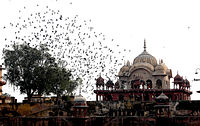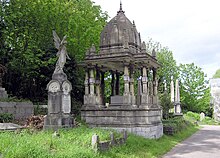
The Rajputana Agency was a political office of the British Indian Empire dealing with a collection of native states in Rajputana, under the political charge of an Agent reporting directly to the Governor-General of India and residing at Mount Abu in the Aravalli Range. The total area of the states falling within the Rajputana Agency was 127,541 square miles (330,330 km2), with eighteen states and two estates or chiefships.

House of Scindia is a Hindu Maratha Royal House that ruled the erstwhile Gwalior State in central India. It had the patil-ship of Kumberkerrab in the district of Wai and was founded by Ranoji Shinde, who started as a personal servant of the Peshwa Bajirao I. Ranoji and his descendants, along with their rivals the Holkars, played a leading role during the Maratha ascendancy in northern India in the 18th-century. The Gwalior State became a princely state during the British Raj in the 19th and the 20th-centuries. After India's independence in 1947 and the abolition of princely states, several members of the Scindia (Shinde) family went on to enter Indian politics.

Suraj Mal was a Jat ruler of Bharatpur in present-day state of Rajasthan. Under him, the Jat rule covered the present-day districts of Agra, Aligarh, Bharatpur, Dholpur, Etawa, Hathras, Mainpuri, Meerut, Mathura, and Rohtak.

Maharaja Jivajirao Scindia KStJ was an Indian prince and government official.

Kumher is a historical town and land of Yaduvanshi Sinsinwars the initial name of this town was Kuber. It is located in Deeg District of Rajasthan, India.

Loharu is a city, municipal committee and assembly constituency, near Bhiwani City in the Bhiwani district of the Indian state of Haryana. It is the administrative headquarters of one of the four administrative sub-divisions of the district and covers 119 villages. It is also a railway junction station.
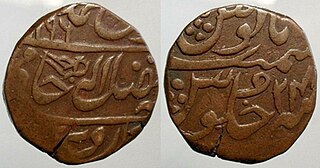
Dhaulpur State or Dholpur State, historically known as the Kingdom of Dholpur, was a kingdom of eastern Rajasthan, India, which was founded in AD 1806 by a Jat ruler Rana Kirat Singh of Gohad. After 1818, the state was placed under the authority of British India's Jatwara. The Ranas ruled the state until the independence of India in 1947, when the kingdom was merged with the Union of India.

Malhar Rao Holkar was a noble subedar of the Maratha Empire, in present-day India. He was one of the early officers along with Ranoji Scindia to help spread the Maratha rule to northern states and was given the estate of Indore to rule by the Peshwas, during the reign of the Maratha emperor Shahu I. He was founder of the Holkar dynasty that ruled Malwa.
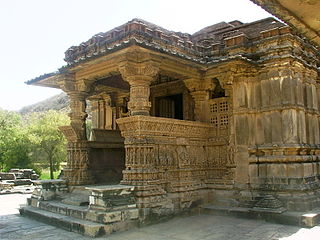
The architecture of the Indian state of Rajasthan has usually been a regional variant of the style of Indian architecture prevailing in north India at the time. Rajasthan is especially notable for the forts and palaces of the many Rajput rulers, which are popular tourist attractions.

The history of human settlement in the west Indian state of Rajasthan dates back to about 5,000 years ago. Around 1400 BC, the Matsya tribe occupied the region. Parts of Rajsthan also belonged to the site of the Indus Valley Civilization. The early medieval period saw the rise of many Rajput kingdoms such as the Chauhans of Ajmer, Sisodias of Mewar, Gurjara-Pratihara and the Rathores of Marwar, as well as several Rajput clans such as the Gohil and the Shekhawats of Shekhawati. While Jat kingdoms include the Johiya of Jangaldesh, the Sinsinwars of Bharatpur State, as well as the Bamraulia clan and the Ranas of Dholpur.

The culture of Rajasthan includes many artistic traditions that reflect the ancient Indian way of life. Rajasthan is also called the "Land of Kings". It has many tourist attractions and facilities for tourists. This historical state of India attracts tourists and vacationers with its rich culture, tradition, heritage and monuments. It also has some wildlife sanctuaries and national parks.

Bharatpur State, which is also known as the Jat State of Bharatpur historically known as the Kingdom of Bharatpur, was a Hindu Kingdom in the northern part of the Indian subcontinent. It was ruled by the Sinsinwar clan of the Hindu Jats. At the time of reign of king Suraj Mal (1755–1763) revenue of the state was 17,500,000 rupees per annual.

Jaswant Singh ki chhatri is a domed pillared pavilion shaped cenotaph, common to Rajasthani architecture, built in c. 1644–58 AD, by Jaswant Singh Rathore in memory of his elder brother Amar Singh Rathore's wife Rani Hada. The chhatri is situated in Rajwara, Balkeshwar, along the banks of river Yamuna, in Agra, and is now maintained by Archaeological Survey of India (ASI) as a monument of National importance.

Naruka is a clan of Rajputs found in India. Naruka Rajputs are offshoots of Maharao Naru Singh of Mozamabad, whose grandfather, Rao Bar Singh, gave up the throne of Amer kingdom. Rao Bar Singh was the eldest son of Raja Udaikarna of Amer. Naruka is the most prominent clan among Kachhwaha and holds an exceptional position in the history of India. They independently ruled on Alwar State.
Alampur is a town and a nagar panchayat in Bhind district in the Indian state of Madhya Pradesh. Alampur is known for its history, for the chhatri of Malhar Rao Holkar which is in Alampur.
Ghasera Fort is a ruined fort in Ghasera village in Nuh district of Haryana state in northern India, which has been notified as a protected monument by the state government. Currently, the majority of the residents of the village are Muslim Meos, though Hindus also live there.

Kusum Sarovar is a sacred water reservoir with a historic sand monument in its backdrop. It is situated on the holy Govardhan Hill between Manasi Ganga and Radha Kund in Mathura district of Uttar Pradesh, India. Kusum Sarovar is considered one of the sacred spots that witnessed the pastimes of Hindu deities Radha and Krishna. It is also the place of Jat ruler Maharaja Suraj Mal's memorial chhatri. Kusum Sarovar has Narada Kund, where Bhakti Sutra verses were written by Narada and the Shri Radha Vana Bihari Temple in the vicinity.

Khanderao Holkar was the only son of Malhar Rao Holkar, the founder of the Holkar dynasty of Indore, and Gautama Bai. He was the husband of Ahilyabai Holkar. He served as a Maratha Sardar and fought several campaigns on behest of the Maratha empire.
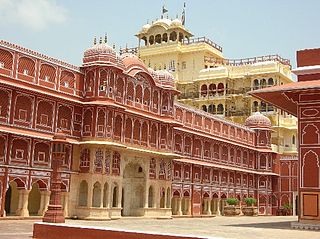
Rajput architecture is an architectural style notable for the forts and palaces of the many Rajput rulers, which are popular tourist attractions, many of the Rajput forts are UNESCO World Heritage Site.





